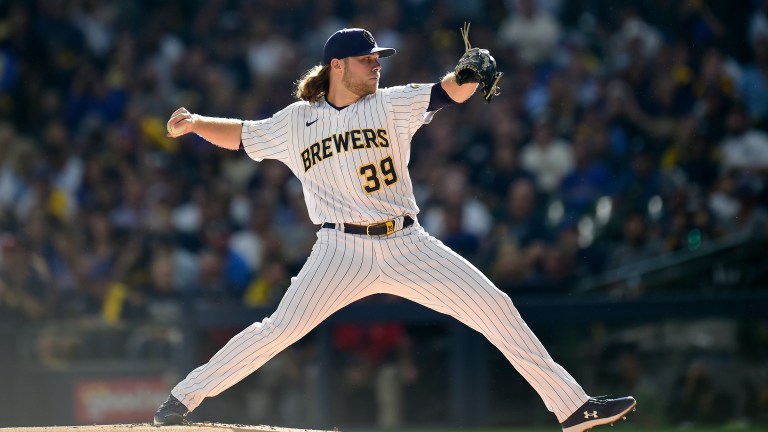NL Cy Young Award: The Final Look
One final check in and prediction on the NL Cy Young Award.

Last time we checked in on the NL Cy Young race, each pitcher had a couple of starts left before the conclusion of the regular season. It is hard to say that two starts could make or break each player’s candidacy, but the race is so close that it could very well be the case.
Each pitcher’s final couple starts, paired with more research on each player’s overall season as well as the history of the award prompted me to write one final rundown of this iron-tight race.
The Blake Snell Precedent
Corbin Burnes leads all of baseball in just about every important pitching category. His 2.43 ERA, 1.63 FIP, 12.61 K/9, and 7.5 WAR are all the best in the game. The one knock on Burnes is his limited total innings; no MLB starter has ever won a Cy Young award with less than 180 innings pitched (Blake Snell-2018).
Snell took home the AL Cy Young three years ago by pitching to a ridiculous 1.89 ERA in 31 starts. There were plenty of people who believed the award should have gone to Justin Verlander, who Snell edged out by just 7% of the vote share.
| Blake Snell | Vote Share: 80% | ERA: 1.89 | FIP: 3.16 | IP: 180.2 | WHIP: 0.97 | bWAR: 7.1 | K/9: 11.01 |
| Justin Verlander | Vote Share: 73% | ERA: 2.52 | FIP: 2.77 | IP: 214 | WHIP: 0.90 | bWAR: 6.9 | K/9: 12.2 |
| Corey Kluber | Vote Share: 34% | ERA: 2.89 | FIP: 2.70 | IP: 215 | WHIP: 0.99 | bWAR: 5.7 | K/9: 9.29 |
If I remember correctly, I was clamoring for Justin Verlander to take home the award. Snell’s season was fantastic, however 31 innings is a lot; enough innings to potentially regress a little. Snell’s FIP (3.16) implied that a regression may have been imminent. Advanced stats are a difficult line to toe when considering awards, because many of them can point towards luck or provide an indication of what we can expect moving forward from a player.
That said, a 1.89 ERA is a 1.89 ERA. Whether every bounce went Blake Snell’s way or not, his 2018 numbers are what writers looked at when the cast their vote. If Snell had thrown the same amount of innings as Verlander and Kluber, the conversation would just end there-but, he didn’t. This brings me back to the regression point in which it almost feels like Snell escaped normalization by pitching less.
Now, I am not saying Snell was pulling a Jose Reyes by bunting for a hit before taking himself out of the game to secure the batting title, but the question of whether Snell’s numbers would’ve been as dominant after four or five more starts seems like a valid one.
Regardless, the Cy Young went to Snell, making him the starting pitcher with the least amount of innings ever to win the award. On the National League side of things, Jacob deGrom won the award with only 10 wins back in 2018–and deservedly so. This served as an ice breaker for what is a new way in which we perceive a pitcher’s value.
2021 NL Cy Young Picture
This year’s NL Cy Young race is poised to be similarly close to 2018’s, but will the voters approach it the same way? What are the similarities and differences between the two years and what conclusions can we draw from them?
| Corbin Burnes | ERA: 2.43 | FIP: 1.63 | IP: 167 | WHIP: 0.94 | bWAR: 5.6 | K/9: 12.61 |
| Max Scherzer | ERA: 2.47 | FIP: 2.97 | IP: 179 | WHIP: 0.86 | bWAR: 6.0 | K/9: 11.84 |
| Zack Wheeler | ERA: 2.78 | FIP: 2.59 | IP: 213 | WHIP: 1.01 | bWAR: 7.6 | K/9: 10.42 |
All three of these guys were magnificent this year. Each pitcher has their strengths to their case and weaknesses–even the absurdly dominant Corbin Burnes. Drawing similarities to the aforementioned 2018 AL Race, Burnes is comparable in many ways to Blake Snell–better numbers, much smaller workload.
The added headache here is that Scherzer is the next closest to Burnes in many important pitching categories, but hardly has more innings than him. Wheeler is a step behind the other two in many pitching figures, but has 43 more innings pitched than Burnes and 31 innings more than Scherzer. If Scherzer had 200 innings, that would be enough for me to put him over the top if I were a voter, but 12 innings just isn’t enough to offset Corbin Burnes’ dominance…but is any amount of innings capable of doing that?
The stark difference between Burnes and Snell in 2018 is that the advanced numbers point toward him actually being better than his already insane surface level numbers. If you want to dock Burnes for throwing only 167 innings, that is fair, but there is not much reason to expect that Burnes was due for any regression.
Ironically, the difference in innings between Verlander and Snell (43 IP) vs. Scherzer and Burnes (46 IP) is nearly identical. Yes, Burnes’ workload is less than that of Snell’s in 2018, but as that season showed us, it is important to compare players to their peers that season because the game is so frequently changing. In 2018, 22 players tossed at least 190 IP; this year, baseball only had seven pitchers exceed that threshold.
Aside from innings pitched, the only major leg up Zack Wheeler has on the other two finalists is bWAR–Baseball-reference’s context-neutralized version of Runs Allowed. In that category, however, Wheeler is ahead of Scherzer and Burnes by 1.6 and 2.0 respectively.
FanGraphs measurement of WAR is FIP based, which of course would favor Burnes, thanks to his unbelievable ability to keep the ball in the yard and by far league-leading FIP. That considered, Burnes only has a 0.2 edge over Wheeler, but a 2.1 edge over Scherzer. In 2018, Verlander had Snell beat by 1.9 fWAR thanks to his strong FIP. On the flip side, Snell edged out Verlander by 0.2 bWAR.
So Who’s Winning This Thing?
With the way that the game is trending in terms of what numbers matter, I still believe that this award will go to Burnes. In a game that is dominated by the long ball, it is beyond impressive how successful Burnes was at keeping the ball in the yard–especially when your home games are in the bandbox that is American Family Field. You just don’t see guys putting up HR/9 figures of 0.38, while still walking nobody.
The limited workload of Burnes is definitely something that even I had to get past, but when a pitcher takes control the way Burnes did when he was on the mound, it makes it a bit more palatable. The holes that can be poked in Scherzer and Wheeler open the door for Burnes a bit as well. If you could combine Scherzer’s numbers with Wheeler’s workload, I would absolutely side with that superhuman, but you can’t and there is enough missing in those two’s resume to overlook Burnes’ 167 innings.
My prediction is that the Cy Young will go to Corbin Burnes, and we will have a new precedent set on the award.

